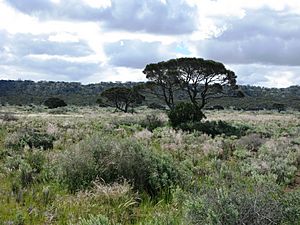Western myall facts for kids
Quick facts for kids Western myall |
|
|---|---|
 |
|
| Western myall on the Roe Plains, near Madura, Western Australia | |
| Scientific classification | |
| Genus: |
Acacia
|
| Species: |
papyrocarpa
|
 |
|
| Occurrence data from AVH | |
The Acacia papyrocarpa, often called the western myall, is a type of tree. It belongs to the Fabaceae family, which is also known as the pea family. You can find this tree growing naturally in the dry, central, and western areas of Australia. It's a tough plant that thrives in places with very little rain.
What Does Western Myall Look Like?
Western myall trees usually grow as a large shrub or a straight tree. They can reach a height of about 2 to 8 m (6 ft 7 in to 26 ft 3 in), but some can grow as tall as 10 m (33 ft). These trees have grey bark that often has cracks in it. Their top part, called the crown, is thick and can be wide or rounded.
The branches of the western myall hang down and are covered in fine hairs. Like many Acacia species, it doesn't have true leaves. Instead, it has special flat, leaf-like parts called phyllodes. These phyllodes are a grey-green color, straight, and flat. They are usually between 4 to 12 cm (1.6 to 4.7 in) long and 1 to 2 mm (0.039 to 0.079 in) wide. The hairy phyllodes have pointed tips that are curved but not sharp. They also have many faint lines running along them.
The tree blooms, or flowers, between August and November. Its flowers are yellow and grow in round clusters. Each cluster is about 5 mm (0.20 in) across and holds 20 to 25 golden flowers. After the flowers, thin, flat seed pods grow. These pods are about 11 cm (4.3 in) long and 4 to 10 mm (0.16 to 0.39 in) wide. Inside the pods are slightly shiny, dark brown seeds. These seeds are shaped like a wide oval and are about 4.5 to 5 mm (0.18 to 0.20 in) long.
How Western Myall Got Its Name
The scientific name for the western myall, Acacia papyrocarpa, was first officially described by a botanist named George Bentham. He did this in 1864 as part of his big book called Flora Australiensis.
Later, in 2003, another botanist named Leslie Pedley changed its name to Racosperma papyrocarpum. But then, in 2006, it was moved back to the Acacia group. So, its main name is Acacia papyrocarpa again. It also has a couple of other old names, Acacia sowdeni and Acacia sowdenii, which are now considered synonyms.
Where Western Myall Grows
The western myall is a plant that is endemic to Australia. This means it naturally grows only in certain dry parts of central Australia. You can find it on limestone plains in southern Australia. Its range stretches from Paynes Find in Western Australia all the way east into South Australia.
There's also one unusual sighting of this tree near Cooper Creek in Queensland. A special type of western myall that grows at Roxby Downs, South Australia is known as the water myall because of its drooping branches. This tree often grows on low limestone hills or on flat areas with salty or clay soil. It prefers sandy loam or clay soils that contain limestone.

